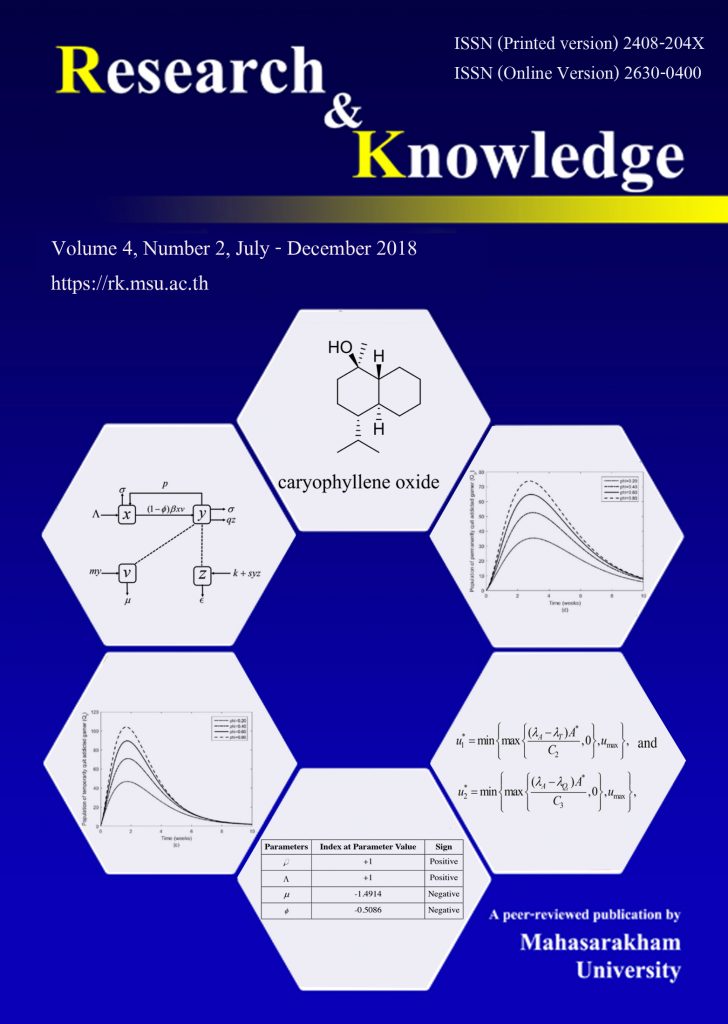Modeling the effect of drug therapy on hepatitis B virus infection
Keywords:
Hepatitis B virus, cytotoxic T lymphocytes, hepatocyte, sensitivity, drug therapyAbstract
With an increase in hepatitis B virus (HBV) infection every year around the world, particularly in developing countries, a mathematical model involving the relationship between HBV and the cytotoxic T lymphocytes (CTL)-mediated immunity is constructed. The model also includes non-cytolytic cure process and drug therapy of HBV. The basic reproduction number R0 is calculated and becomes threshold for equilibrium point stabilities. Sensitivity analysis is carried out to seek for potential parameters that could reduce overall spread of HBV infection. The numerical and sensitivity analyses show that both effectiveness of drug therapy in blocking new infection and non-cytolytic cure process play a key role in reducing the concentration of infected hepatocytes and free virus. Therefore, HBV drug therapy should be encouraged as one of the approaches to reduce overall chronic HBV infection.
References
Ahmed, R. and Gray, D. 1996. Immunologycal memory and protective immunity. Understanding their relation. Science 272, 54-60.
Andersen, M. H., Schrama, D., Straten P. T. and Becker, J. C. 2006. Cytotoxic T cells. Journal of Investigative Dermatology 126(1), 32-41.
Bralet, M.P., Branchereau, S., Brechot, C. and Ferry, N. 1994. Cell lineage study in the liver using retroviral mediated gene transfer. American Journal of Pathology 144, 896-905.
Behrouz, N., Narges, M., Arezoo, E., Mehdi, M. and Hossein, P. 2011. Hepatitis B virus infection during pregnancy: transmission and prevention. Middle East Journal of Digestive Diseases 3(2), 92-102.
Ciupe, S. M., Ribeiro, R. M., Nelson, P. W., Dusheiko, G. and Perelson, A. S. 2007a. The role of cells refractory to productive infection in acute hepatitis B viral dynamics. Proceedings of the National Academy of Sciences of the United States of America 104, 5050- 5055.
Ciupe, S. M., Ribeiro, R. M., Nelson, P. W. and Perelson, A. S. 2007b. Modeling the mechanisms of acute hepatitis B virus infection. PMC US National Library of Medicine National Institutes of Health, 247(1), 23-35.
Ciupe, S. M., Ribeiro, R. M. and Perelson, A. S. 2014. Antibody Responses during hepatitis B Viral Infection. PLOS Computation Biology 10(7), e1003730.
Eikenberry, S., Hews, S., Nagy, J. D., Kuang, Y. 2009. The dynamics of a delay model of HBV infection with logistic hepatocyte growth. Mathematical biosciences and engineering 6, 283-299.
Foundation for Liver Research. Hepatitis B: Out of the shadows (A report into the impact of hepatitis B on the nation’s health). 2004. Retrieved January 18, 2017, from http://www.liver-research.org.uk/liverresearch-fi les/Hepatitis-B-Out-of-the-Shadows.pdf.
Henry, J. P., Simona, C. K., Su, H. W., Laura, C. W. and Chau, T. S. 2014. Chronic hepatitis B and liver cancer risks among Asian immigrants in New York City: results from a large, community-based screening, evaluation, and treatment program. Cancer Epidemiol Biomarkers Prevention 23(11), 2229-2239.
Hou, J., Liu, Z. and Gu, F. 2005. Epidemiology and prevention of hepatitis B virus infection. International Journal of Medical Sciences 2(1), 50-57.
Kerkvliet, N. and Lawrence, B. P. 2010. 5.05-Cytotoxic T cell. Comprehensive Toxicology (2nd Ed.) 5, 109-132.
Koonprasert, S., Moore, E. J. and Banyatlersthaworn, S. 2016. Sensitivity and Stability Analysis of hepatitis B virus model with non-cytolytic cure process and logistic hepatocyte growth. Global Journal of Pure and Applied Mathematics 12, 2297-2312.
Long, C. and Qi, H. 2007. A dynamic model for the hepatitis B virus infection. Systemics, Cybernetics and Informatics 5(1), 1690-4524.
Lewin, S., Ribeiro, R., Walters, T., Lau, G., Bowden, S., et al. 2001. Analysis of hepatitis B viral load decline under potent therapy: complex decay profi les observed, Hepatology 34, 1012-1020.
Liaw, Y. F., Kao, J. H., Piratvisuth, T., Chan, H. L., Chien, R. N., Liu, C. J., et al. 2012. Asian-Pacifi c consensus statement on the management of chronic hepatitis B: a 2012 update. Hepatology International 6, 531-561.
Lim, K. S., Taamwong, V., Fulford, K. W. M., Catterall, R. D., Briggs, M. and Dane, D. S. 1977. Role of sexual and non-sexual practices in the transmission of hepatitis B. British Journal of Venereal Diseases 53, 190-192.
MacDonald, R. A. 1961. “Lifespan” of liver cells. Autoradio-graphic study using tritiated thymidine in normal, cirrhotic, and partially hepatectomized rats. Arch Intern Med 107, 335-343.
Mboya, K., Makinde, D. O. and Massawe, E. S. 2015. Cytotoxic cells and control strategies are effective in reducing the HBV infection through a mathematical modelling. International Journal of Prevention and Treatment 4(3), 48-57.
Ngoteya, F. N. and Gyekye, Y. N. 2015. Sensitivity analysis of parameters in a competition model. Applied and Computational Mathematics 4(5), 363-368.
Nowak, M. A., Bonhoeffer, S., Hill, A., Boehme, R., Thomas, H. and McDade, H. 1996. Viral dynamics in hepatitis B infection. Proceedings of the National Academy of Sciences of the United States of America 93, 4398-4402.
Nowak, M. A. and May, R. M. 2000. Viral dynamics. Oxford University Press, Oxford. Perrillo, R. 2009. Benefi ts and risks of interferon therapy for hepatitis B. Hepatology 49(5), 103-111.
Richard, G. and Hock Foong, L. 2011. Treatment of hepatitis B in decompensated liver cirrhosis. International Journal of Hepatology, Volume 2011, Article ID 918017, 11 pages.
Samsuzzoha, M. D., Singh, M. and Lucy, D. 2013. Uncertainty and sensitivity analysis of the basic reproduction number of a vaccinated epidemic model of influenza. Applied Mathematical Modelling 37, 903-915.
van den Driessche, P. and Watmough, J. 2002. Reproductive numbers and sub-threshold endemic equilibria for compartment models of disease transmission. Mathematical Biosciences 180, 29-48.
Whalley, S. A., Murray, J. M., Brown, D., Webster, G. J. M., Emery, V.C., Dusheiko G. M. and Perelson, A. S. 2001. Kinetics of acute hepatitis B virus infection in humans. Journal of Experimental Medicine 193, 847-853.
Wodarz, D. 2003. Hepatitis C virus dynamics and pathology: the role of CTL and antibody responses. Journal of General Virology 84, 1743-1750.
Yousfi , N., Hattaf, K. and Tridane, A. 2011. Modeling the adaptive immune response in HBV infection. Journal of Mathematical Biology 63, 933-957.
Zuckerman, A. J. 1996. Chapter 70 Hepatitis viruses. Medical Microbiology, 4th edition. University of Texas Medical Branch at Galveston. WHO (World Health Organization), Hepatitis B fact sheet no. 204. The World Health Organization, Geneva, Switzerland, 2017. Retrieved January 2, 2017, from, http://www.who.int/mediacentre/factsheets/fs204/en/
Downloads
Published
Issue
Section
License

This work is licensed under a Creative Commons Attribution-NoDerivatives 4.0 International License.





